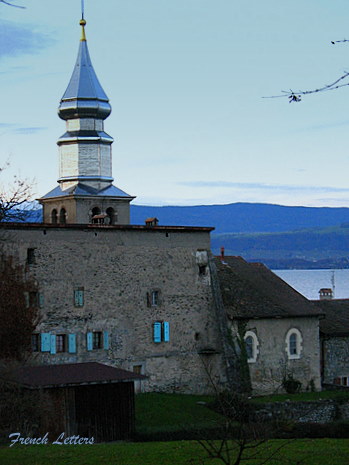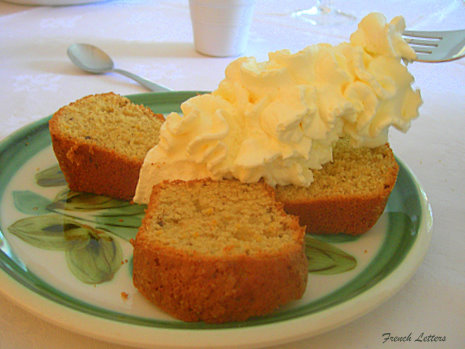
I want each and every one of you to feel like a kid in a candy store – a French candy store, that is! Here’s your chance to win a sumptuous collection of candy, consisting of a wooden box of the iconic glazed chestnuts called Marrons Glacés (in this case with the added benefit of Cognac), that irresistable soft almond Nougat de Montélimar, a Lindt Connaisseur’s Collection of classic chocolate bonbons, the famous candied orange peels coated in dark chocolate known as Orangettes, mint flavored dark chocolate Sarments du Médoc in the shape of beautiful little twigs, and a set of liqueur-filled bonbons with Cognac, Framboise, Marc de Champagne, Poire Williams, Chartreuse, Grand Marnier, and Kirsch. I will wrap this with my own two hands and ship this dessert delight directly to you, just one very special person among you all, dear French Letters readers, wherever you may be, anywhere in the world. Now how’s that for an offer you can’t refuse?

Have you heard about the Menu for Hope?
Menu for Hope is an annual fundraising campaign hosted worldwide by Chez Pim and here in Europe by David Lebovitz. The first Menu For Hope was born five years ago in response to the devastating tsunami in Southeast Asia, and the campaign has since become a yearly extravanza of generosity. Over the past three years, Menu for Hope has raised nearly a quarter of million dollars in support of the good work of the UN World Food Programme, helping to feed hungry people worldwide.
Each December, food bloggers from all over the world join the campaign by offering a delectable array of food-related prizes for the Menu for Hope raffle. In the case of French Letters, it’s a delectable array of French candy, hand selected by me to make your New Year sweet and bright. Anyone , and especially you, can buy raffle tickets for the French Letters bid item, cleverly named Bid Item EU06. Of course, you’re cordially invited to also bid on the fabulous prizes offered by other bloggers all over the world, but I’m hoping that French Leaders readers will dig deep into their credit cards and go for the candy first!
For every $10 you donate, you earn one virtual raffle ticket to bid on a prize of your choice. At the end of the two-week campaign, the raffle tickets are drawn and the results announced on Chez Pim. This year’s campaign is taking place December 14 through Christmas. I know you’re busy baking cookies, but since you can’t send those treats to hungry kids around the world, please bid on this pile of candy and assuage your conscience while spreading holiday cheer.
Once again the beneficiary of this year’s campaign is the UN World Food Programme. WFP is the world’s largest food aid agency, working with over 1,000 other organizations in over 75 countries. In addition to providing food, the World Food Program helps hungry people to become self-reliant so that they have a chance to escape hunger for good.
This year, Menu For Hope is supporting a new initiative at the WFP called Purchase for Progress (P4P). P4P enables smallholder and low-income farmers to supply food to WFP’s global operation. P4P helps farmers improve farming practices and puts more cash directly into their pockets in return for their crops. This will also help buoy local economies by creating jobs and income locally. Should you have the least shred of doubt, you can learn more about P4P here.
And by the way, I won’t be collecting any of the money, nor will any of the other bloggers participating in the campaign. All the money is collected by an online fundraising company called FirstGiving, which has worked with Menu For Hope since the beginning.
Here’s how it works. You want to bid, you know you do! You’ve looked at the list of all the wonderful items offered for raffle here. You know what you want, so go get it, using the easy bidding form available below the list!
Easy as pie, you make an online (tax deductible) donation by bidding on the item or items of your choice, with a credit card. Be sure to follow the easy steps in the bidding instructions. The minimum bid is $10 and you can bid as many times as you like, and on as many items as you like. To win this collection of French bonbons, make sure to put the item number (EU06) next to your bid(s) and use a valid email address.
FirstGiving will collect and process the payments and, at the end of the campaign, transfer the donations in one lump sum to the WFP. This is a win-win situation for all parties involved. The bloggers never touch the money. The WFP doesn’t waste time processing mini-donations, the majority of which are between $10-$50. Firstgiving does all the work and collects a small fee, which include the credit card processing charges. If your ticket is drawn, and I hope it will be, you are richly rewarded, in the case of the French Letters bid item (EU06), with a gorgeous selection of yummy French treats.
Here’s what you need to do:
1. Choose a bid item or bid items of your choice from our Menu for Hope main bid item list .
2. Go to the donation site at Firstgiving and make a donation.
3. Please specify which bid item you’d like in the ‘Personal Message’ section in the donation form when confirming your donation. You must write-in how many tickets per bid item, and please use the bid item code (EU06).
Each $10 you donate will give you one raffle ticket toward a bid item of your choice. For example, a donation of $50 can be 2 tickets for EU06 and 3 tickets for other items on offer.
4. If your company matches your charity donation, please check the box and fill in the information so we can claim the corporate match.
5. Please check the box to allow us to see your email address so that we can contact you in case you win. Your email address will not be shared with anyone.
So, ready, set, bid here! How sweet is that?









































































